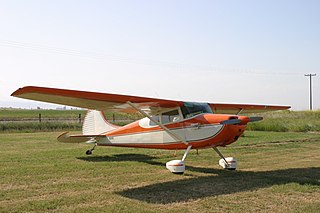
The Cessna 170 is an American light, single-engined, general aviation aircraft produced by the Cessna Aircraft Company between 1948 and 1956.

The Bell XV-15 is an American tiltrotor VTOL aircraft. It was the second successful experimental tiltrotor aircraft and the first to demonstrate the concept's high speed performance relative to conventional helicopters.
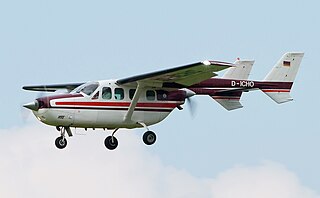
The Cessna Skymaster is an American twin-engine civil utility aircraft built in a push-pull configuration. Its engines are mounted in the nose and rear of its pod-style fuselage. Twin booms extend aft of the wings to the vertical stabilizers, with the rear engine between them. The horizontal stabilizer is aft of the pusher propeller, mounted between and connecting the two booms. The combined tractor and pusher engines produce centerline thrust and a unique sound. The Cessna O-2 Skymaster is a military version of the Cessna 337 Super Skymaster.

The Bell X-22 is an American V/STOL X-plane with four tilting ducted fans. Takeoff was to selectively occur either with the propellers tilted vertically upwards, or on a short runway with the nacelles tilted forward at approximately 45°. Additionally, the X-22 was to provide more insight into the tactical application of vertical takeoff troop transporters such as the preceding Hiller X-18 and the X-22's successor, the Bell XV-15. Another program requirement was a true airspeed in level flight of at least 525 km/h.
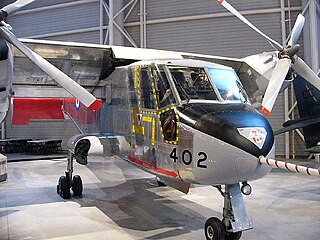
The Canadair CL-84 "Dynavert", designated by the Canadian Forces as the CX-131, was a V/STOL turbine tiltwing monoplane designed and manufactured by Canadair between 1964 and 1972. Only four of these experimental aircraft were built with three entering flight testing. Two of the CL-84s crashed due to mechanical failures, with no fatalities occurring in either of the accidents. Despite the fact that the CL-84 was successful in the experimental and operational trials carried out between 1972 and 1974, none of the prospective customers placed any orders for the type.

The Ryan XV-5 Vertifan was a jet-powered V/STOL experimental aircraft in the 1960s. The United States Army commissioned the Ryan VZ-11-RY in 1961, along with the Lockheed VZ-10 Hummingbird. It successfully proved the concept of ducted lift fans, but the project was cancelled after multiple fatal crashes unrelated to the lift system.

The Lockheed XV-4 Hummingbird was a U.S. Army project to demonstrate the feasibility of using VTOL for a surveillance aircraft carrying target-acquisition and sensory equipment. It was designed and built by the Lockheed Corporation in the 1960s, one of many attempts to produce a V/STOL vertical take off/landing jet. Both prototype aircraft were destroyed in accidents.

The Ling-Temco-Vought (LTV) XC-142 was a tri-service tiltwing experimental aircraft designed to investigate the operational suitability of vertical/short takeoff and landing (V/STOL) transports. An XC-142A first flew conventionally on 29 September 1964, and on 11 January 1965, it completed its first transitional flight by taking off vertically, changing to forward flight and finally landing vertically. Its service sponsors pulled out of the program one by one, and it eventually ended due to a lack of interest after demonstrating its capabilities successfully.

The Dornier Do 27 is a German single-engine STOL utility aircraft that was designed and manufactured by Dornier GmbH. It was notable for being the first mass-produced aircraft in Germany following the end of the Second World War.

The Fuji FA-200 Aero Subaru is a single-engine piston-powered monoplane built by Fuji Heavy Industries of Japan.

The Anderson Greenwood AG-14 is a two-seat utility aircraft developed in the United States shortly after World War II. It is an all-metal, shoulder-wing monoplane of pod-and-boom configuration, equipped with a pusher propeller, side-by-side seating and fixed tricycle undercarriage.

The Breguet 941 was a French four-engine turboprop STOL transport aircraft developed by Breguet in the 1960s. Although widely evaluated, it was not built in large numbers, with only one prototype and four production aircraft being built.
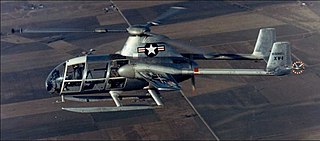
The McDonnell XV-1 is an experimental gyrodyne developed by McDonnell Aircraft for a joint research program between the United States Air Force and the United States Army to explore technologies to develop an aircraft that could take off and land like a helicopter but fly at faster airspeeds, similar to a conventional airplane. The XV-1 would reach a speed of 200 mph, faster than any previous rotorcraft, but the program was terminated due to the tip-jet noise and complexity of the technology which gave only a modest gain in performance.

The Curtiss-Wright VZ-7 was a VTOL quadrotor helicopter aircraft designed by the Curtiss-Wright company for the US Army. Like the Chrysler VZ-6 and the VZ-8 Airgeep it was to be a "flying jeep".

The Mississippi XAZ-1 Marvelette was an American research aircraft of the 1960s. A converted Anderson Greenwood AG-14 light single-engined pusher aircraft, it provided the test-bed, or test platform, on which to test the boundary layer control system and ducted propeller installation of the planned XV-11 Marvel STOL research aircraft. One aircraft was converted to XAZ-1 configuration; although underpowered, it provided valuable test data over a year-long flight program. Following the conclusion of test flying, the aircraft was used for ground testing before being scrapped.

The Dornier Do 29 was an experimental aircraft developed by Dornier Flugzeugwerke and the Deutsche Versuchsanstalt für Luftfahrt in the 1950s, used to test a tilting-propeller system for short takeoff and landing (STOL) aircraft. The concept was proved to be successful in flight testing; however, no further development of the system or aircraft was proceeded with, and at the conclusion of its test program the Do 29 was retired.
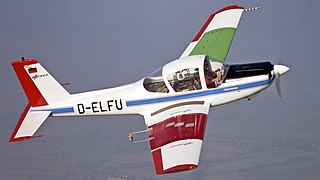
The LFU 205 is a single-engined, four-seat, low-wing monoplane, that was built in the late 1960s entirely from glass reinforced plastic. Only one was produced but this machine continues to fly in a research program into laminar flow over wings.
The Bede XBD-2 was an experimental short takeoff and landing (STOL) aircraft, with several novel features such as structural use of glass-fibre and aluminium honeycomb, a suction boundary layer control (BLC) system and fuselage-mounted twin engines driving a pusher configuration, shrouded single propeller. The sole example flew in the early 1960s in the United States.
The Bede BD-3 is a prototype six passenger homebuilt aircraft.

The XTI TriFan 600 is a vertical takeoff and landing aircraft currntly under development by XTI Aircraft Company.



















